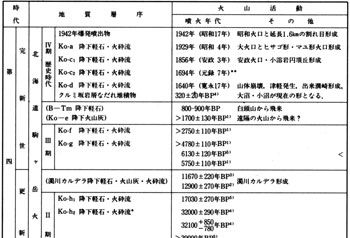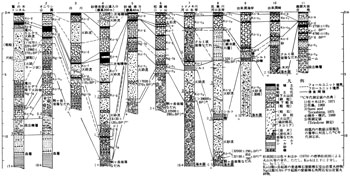Komagatake Volcano
1: Introduction / Geology of Komagatake Volcano and environs / Outline of Komagatake Volcano
2: Geology and history of activities of Komagatake Volcano
3: Eruptions of Komagatake Volcano in historical times
4: Rocks of Komagatake Volcano
5: Surveillance and observation of volcanc activities - Future surveillance and prevention of disaster
6: References
![]() PREV
PREV ![]() NEXT
NEXT
2: Geology and history of activities of Komagatake Volcano
Since its formation as stratovolcano several ten thousand years ago, two collapses of mountaintop and many pumice eruptions occurred. As shown in ![]() Table 1, the deposits are classified from stage I to stage IV according to their ages. The history of the Komagatake became clear from rock distributions and stratigraphic studies ( cf., volcanic geologic map and
Table 1, the deposits are classified from stage I to stage IV according to their ages. The history of the Komagatake became clear from rock distributions and stratigraphic studies ( cf., volcanic geologic map and ![]() Fig. 1 ). The history is briefly summarized in the following description in which C-14 age data with stratigraphic positions and the reference sources are clearly noted in
Fig. 1 ). The history is briefly summarized in the following description in which C-14 age data with stratigraphic positions and the reference sources are clearly noted in ![]() Fig. 1.
Fig. 1.
Stage I ejecta
Komagatake Lava: Komagatake Volcano is mostly covered by volcanic ejecta belonging to after stage II. The ejecta belonging to stratovolcanic stage are only exposed at the summit as part of Kenga-Mine and west of Sahara-Dake. Those two peaks are composed of thick pyroxene andesite lava collectively called Komagatake Lava. It is overlain by welded pyroclastic flow deposits of after stage II.
Stage II ejecta
Komagatake debris avalanche deposits: In western and northeastern foot areas, Komagatake debris avalanche deposits consisting of pyroxene andesite boulders ( up to 5m across ) and fine-grained powdery deposits of the same composition are widely distributed. This was called ' mud flow deposits ' at one time. They cover terrace deposits in the west. The deposits are distributed in NE foot at Matsuyazaki coast and NW flank at the upper reach of Oshiyamazawa Creek and other valley bottoms. However, underlying beds are not exposed, while overlain by pumice fall and pyroclastic deposits belonging to Stage II. The debris avalanche deposits are poorly sorted, magnetic directions of included fragments are inconsistent, and are distributed as groups of small hills. The origin of the deposits is interpreted as follows: after the formation of stratovolcano, the mountaintop has collapsed due to phreatic explosion resulting in low temperature debris avalanche. The thickness of avalanche deposits are: southern foot area unknown, western foot area 5-25 m, and Matsuyazaki at NE foot area 32 m. Much of the summit area seems to have been lost by this collapse.
Ko-h2 pumice fall and pyroclastic flow: In the coastal area of NE foot, weathered surface of Komagatake debris avalanche deposits are covered by coarse-grained pumice fall and pyroclastic flow deposits. Overlying deposits are named as Shikabe Pumice Fall and Pumice Flow deposits ( Yanai and Ganzawa, 1988 ).
The pumice fall is distributed from the west foot to southeast. At Oiwa Plateau ( a terrace ) of Shikabe, one of the type localities of the Komagatake pyroclastic fall deposits, this pumice fall is correlated to the lower half of Ko-h fall. Here we call it Ko-h2 pumice fall. The axis of distribution of the fall seems to lie to the east of this area. The pumice fall buried forest and the C-14 age of the carbonized wood is somewhere between 320,000 to larger than 390,000 yBP ( ![]() Fig. 1 ). Pyroclastic flow deposits accompanied with this pumice fall are distributed in the foot in the north to east. Part of pumice flow is welded. The deposits are correlated to the rocks called Dekimazaki welded tuff and Oritogawa welded tuff ( Katsui et al., 1975 ).
Fig. 1 ). Pyroclastic flow deposits accompanied with this pumice fall are distributed in the foot in the north to east. Part of pumice flow is welded. The deposits are correlated to the rocks called Dekimazaki welded tuff and Oritogawa welded tuff ( Katsui et al., 1975 ).
Ko-h1 pumice fall and pyroclastic flow: In west and north foot areas along with SE area, weathered surface of Ko-h2 pumice fall deposits are covered by Ko-h1 pumice ( and ash ) fall. In the north foot area it is accompanied with pyroclastic flow ( not shown in the geologic map ). Carbonized wood chip included in it gave C-14 age of 17,000 yBP ( ![]() Fig. 1 ).
Fig. 1 ).
Pumice and ash fall of Nigorikawa Caldera
Komagatake Volcano became dormant for about 11,000 years after large-scale collapse and two pumice eruptions which occurred between about 30,000-40,000 years ago in stage II. During this dormant time at about 12,000 years ago Nigorikawa Caldera in WNW of Komagatake was formed and Komagatake Volcano was covered by pumice and ash falls from this source. The ejecta from Nigorikawa Caldera are hypersthene-hornblende andesitic pumice and ash different from Komagatake ejecta which are augite-hypersthene andesitic pumice and ash. The Nigorikawa deposits separate stage II and stage III ejecta of Komagatake and gives a good key bed. As are shown in exposures in Oniushi Park and Washinoki Tunnel to the west in Mori in the western foot of Komagatake ( ![]() Fig. 1 ), Ko-h1 pumice fall which is slightly weathered to clay is overlain by ejecta from Nigorikawa Caldera, the top of which is now humus soil, and which in turn overlain by Ko-g pumice fall of stage III. Judged from ejecta, the first erupted from Nigorikawa Caldera was ash, and after some rest followed by small eruption of fine-grained pumice and lithic ash, then Plinian eruption of large amount of pumice fall and lithic fragments, pyroclastic surge, and large-scale pyroclastic flow followed. Pyroclastic flow had only reached around Washinoki Tunnel, but pyroclastic surge widely covers western foot areas.
Fig. 1 ), Ko-h1 pumice fall which is slightly weathered to clay is overlain by ejecta from Nigorikawa Caldera, the top of which is now humus soil, and which in turn overlain by Ko-g pumice fall of stage III. Judged from ejecta, the first erupted from Nigorikawa Caldera was ash, and after some rest followed by small eruption of fine-grained pumice and lithic ash, then Plinian eruption of large amount of pumice fall and lithic fragments, pyroclastic surge, and large-scale pyroclastic flow followed. Pyroclastic flow had only reached around Washinoki Tunnel, but pyroclastic surge widely covers western foot areas.
Stage III ejecta
Ko-g pumice fall and pyroclastic flow: Pumice fall correlated to Ko-g in Oiwa Plateau of Shikabe is widely distributed in western and northern foot areas of Komagatake. The axis of distribution is located in the east but accompanying pyroclastic flow ( scoria-bearing pumice flow ) is seen distributed in northern flank and northeast foot area. C-14 age of carbonized wood found in pyroclastic flow in northern foot area was about 6,000 yBP.
Ko-f pumice fall and pyroclastic flow: Somewhat coarse-grained pumice fall correlated to Ko-f in Oiwa Plateau of Shikabe has its axis of distribution in ESE of Komagatake, but in Dekimazaki coast it was lost to erosion. In north and west foot areas accompanying pyroclastic flow ( pumice flow ) is widely distributed. C-14 age of surface humus of Ko-f pumice fall is 2,750±110 yBP. Therefore pumice eruption of Ko-f seems to have occurred about 3,000 years ago.
Ko-e ash fall: After pumice eruption of Ko-f, Komagatake was dormant for about 3,000 years until 1640. In Komagatake Volcano area, Ko-e ash fall is widely distributed between Ko-f and Ko-d which is described later. Ko-e ash has been regarded to be originating from Komagatake, but the thickness in the immediate foot area and flank is only 10-50 cm even including top humus, and ash itself is 4-10 cm thick with no systematic difference in thickness in Komagatake area. This ash is fine-grained glass fragments including pyroxene and plagioclase crystals, and its provenance must be some volcano remote from Komagatake. C-14 age of humus at the top of Ko-e is given to be 1,700±130 yBP. At places white ash clots are found in humus. This is correlated to B-Tm ash ( originating from Baitoushan. 800-900 yBP, Arai et al., 1986 ).
Stage IV ejecta
Komagatake Volcano became active in 1640 in stage IV ( historical time ) with collapse of mountaintop followed by pumice eruption. The summit lost some height and Dekimazaki Peninsula was formed. In the south foot area, debris avalanche deposit formed hummocky topography with dammed lakes such as Onuma and Konuma. Pumice eruptions were repeated in 1694, 1856, and 1929 accompanied with pyroclastic flows. The surface of Komagatake Volcano is blanketed with those ejecta. In 1942 a phreatic eruption occurred and a fissure was formed in the crater floor. Details of these eruptions in historical times are described next.
 ZOOM
ZOOM 